Nanomatechs – User Interview
May 12, 2020|Interview

Nanocarbon materials, such as carbon nanotubes (CNTs), graphene, and fullerenes, have excellent physical properties, including high electrical conductivity, high thermal conductivity, strong electromagnetic wave absorption, and high lubricity, and are expected as outstanding advanced materials. On the other hand, due to their high cohesiveness, it is extremely difficult to disperse them evenly in resin, etc. In this regard, it is an important issue to extract their physical properties.
Nanomatechs Corporation solves such problems and develops resin composite materials that exhibit the excellent performance of these nanocarbon materials. In this interview, Hiroyuki Murakami, president, talked about his research, his attitude and thoughts as a researcher, and the way he should work in the future society.

Motivation for establishing Nanomatechs Corporation
I used to work for a trading company where I was tasked with the development of new products. At the time, for the promotion of product development, a project team was formed for each theme, which consisted of people from universities, industrial technology research institutes, former members of major electronics companies, people from material manufacturers, processing manufacturers, molding manufacturers, etc. In the case of resin development, for example, a team was formed by combining partners from various fields of specialization, in hopes of being able to consult a particular resin manufacturer when an issue arises.
On one occasion, led by the words of a friend who said, “CNTs are interesting,” I started working on CNT research, but could not start any business related to CNTs. At that time, every major Japanese trading company was conducting research on CNTs. The price of multi-walled CNTs was 30,000 yen per kilogram, which corresponded to only thirty million yen even if as much as one ton was sold. Furthermore, as commercialization was mostly realized by mixing CNTs in the ratio of several percent with resin, the demand needs to be as much as tens of tons for the final product. Thus, their commercialization posed many challenges for every trading company. I believe there hardly remain companies that are still continuing the research at present.
When I think about it now, I was able to establish a broad range of personal connections (as an employee of a trading company) around that time and was able to proceed with the development of various products on the basis of those connections. Because product development used to advance while I gathered various pieces of information from many acquaintances, some customers said, “I would be in trouble if Mr. Murakami left.” In February 2014, I was scheduled to retire from the company and wanted to hand over my jobs, but was told by the company that it did not need a difficult business such as CNTs (laughs). I was in a very awkward position because on the one hand, the company would not continue the business and on the other hand, my colleagues said, “We should not stop here because we have been developing products up to this point.” Then, one of my colleagues said, “You should start a company, Mr. Murakami.” That was how this company was started and has evolved to what it is today.
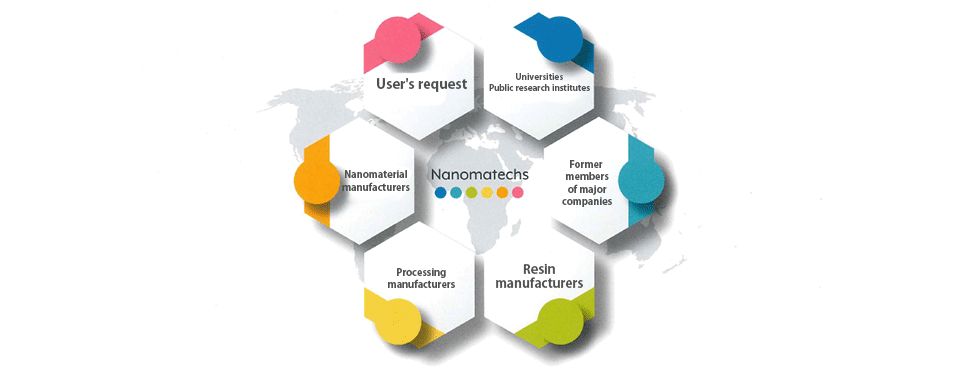
*Nanomatechs deals with nanocarbon materials, such as CNTs, graphene, and fullerenes, and offers one-stop technology for marketing, technological development, commercialization, manufacturing, and sales.
Currently, my job is to solve problems related to product development by customers. Customers encounter a lot of troubles, such as “I want to do this although I do not know whether it is possible or not” and “I made a prototype with carbon for a certain purpose but failed.” I usually start with the challenge of using CNTs to solve such problems. In “seeds” th<>inking, people start with “I want to commercialize CNTs!” and proceed to “Then, what should I make?” In my case, on the other hand, there is the customer’s issue first and therefore, there is definitely a demand.
Features of CNTs and product development
The main feature of CNTs is that “carbon does not break away.”
Pencil lead is made of graphite, which is composed of “C” atoms, in the same manner as CNTs. Being able to write letters on a piece of paper with a pencil means that some graphite is peeled off and sticks to the paper. Further, if carbon used for electronic parts comes into contact with other parts and adheres to them, conductivity and short circuit would occur, leading to breakage. “Being able to conduct electricity without breaking away” should be the main goal of CNT development.
However, “not breaking away” is not always good. Because CNT particles are very fine, they are difficult to remove once they adhere to a desk, etc. In addition, the particles should not be inhaled.
Because CNTs are easier to use if they are processed into an intermediate material rather than in powder form, we have developed a product (masterbatch) that can be directly used for resin injection. We will commercialize products with 5% CNTs, 3% CNTs, etc. depending on customer requirements.
CNTs are interesting if they can be evenly dispersed, and may even become a candidate material for the Nobel Prize if they can be commercialized and sold in large quantities. Because a Japanese researcher discovered their production method, I wish to commercialize them.

*Commercialization of CNTs (envisioned products).
Patents obtained by using THINKY Mixer for product development
At the request of a certain manufacturer, we manufactured a receiving jig for screen printing of solder paste in the mounting process. This jig fixes unevenness when attaching parts to electronic boards. In the past, the four corners of a board were supported by pins, but the board tended to “warp” with only this pin support. In fact, “warpage” was the cause of 90% of product defects in the mounting process. That manufacturer created a jig with epoxy and carbon. However, carbon powder was generated and adhered to the board. Thus, it ended up being unusable as a jig.
I started the development of the jig when some staff dealing with the mounting process said, “We are in trouble. What should we do?” A jig for that use should be not so hard but sufficiently soft so that it will not break when parts are placed on it. Moreover, it was difficult to make a jig from conductive materials. Therefore, it was necessary to produce many types of samples with different specifications including CNT compositions.
At first, the materials were mixed by hand, but because CNTs are thixotropic, they were difficult to mix. Then, I started using a THINKY Mixer that I borrowed from THINKY Corporation. With that, clean mixing was realized, leading to the production of more than 250 samples. (Note by THINKY: Nanomatechs Corporation purchased a THINKY Mixer ARE-310 after that.)
Because I try to create products that meet the needs of customers, I work closely with customers and hold many meetings with them. Many customers do not know exactly what they want. Development will proceed smoothly if I make several samples under various conditions and the customer selects from among them.

*Left: Developed “receiving jig made of CNT-compound resin.” It is made to exactly fit unevenness of board parts.
*Right: Examples of samples. Epoxies are hard by nature. These were made after holding consultations with an acquaintance at Osaka University on how to make epoxies soft.
Topic
Registered patent: Carbon-nanotube-compound resin receiving jig (Patent No. 6540963)
In recent years, electronic devices have become lighter, thinner, shorter, and smaller, and have a thinner electronic board, and electronic components are mounted in higher density. Precision mounting has become difficult with the conventional support pin method. The following shows how to manufacture a resin receiving jig that can solve this problem.
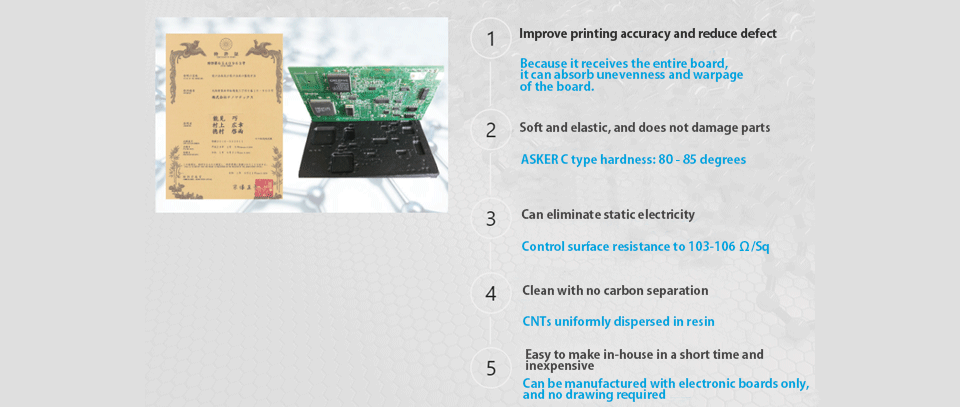
*Quoted from Nanomatechs website (http://nanomatechs.jp/products.html#content5-11)
Nowadays, we receive many requests for consultations on various technical issues
A CNT-containing conductive filament for 3D printers was also developed. Unlike hard resin, soft resin is not well extruded in a 3D printer. When shifting gears, the filament tends to break because it is too soft. When the filament gets stuck, the printer will stop. After spending about a year for development, a conductive filament was successfully created and a patent was applied for in 2018. There is no carbon separation due to the use of CNTs. A 3D printer equipped with this filament enables production of an object that is free from static electricity and absorbs electromagnetic waves.
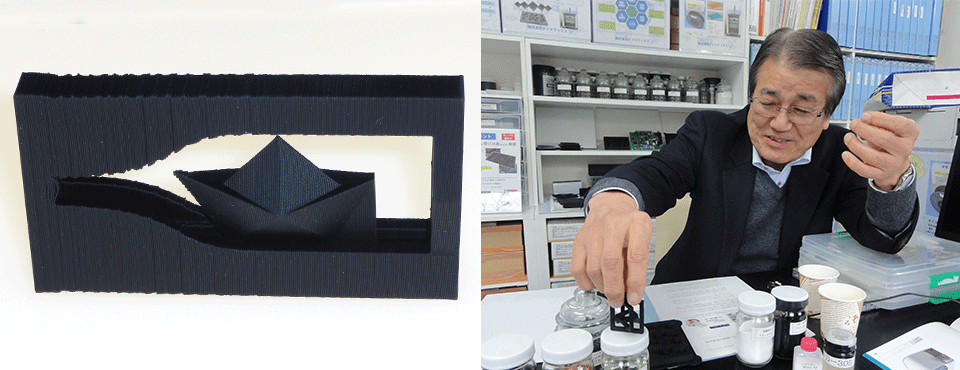
*Left: Ship in a bottle made for fun while developing CNT-containing conductive filaments for 3D printers. “Looks like it’s for sale at Tokyu Hands!”
*Right: “Playfulness is important in daily research.” The interviewer was able to see many other prototypes such as rocket models.
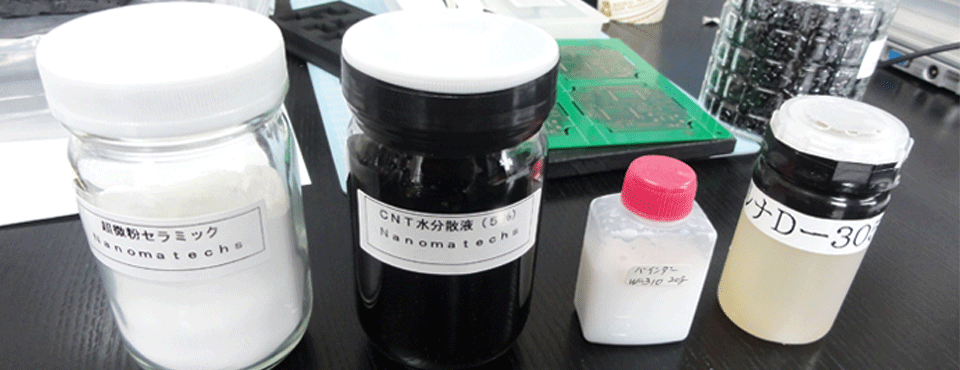
*Ceramic materials
Since my youth, my job has been to make things that do not exist in the world. As I have always been working only on new things, I make nothing of taking on challenges. Some of my seniors used to say, “Create something out of nothing.”
Perhaps because of that, I have had many opportunities to work with people of similar age and who are willing to take on challenges. Although recently, there seem to be many people who shy away from tasks for fear of failure, it is more interesting to take on challenges without fear of failure.
If the development process is difficult and results in many failures, the resulting product will be neither easily copied nor imitated. No one wants to go through research and development with lots of failures without a clear application target in mind. By listening to customer’s issues and problems at the start, we are able to clearly define the goal that “the product will sell well if it has a definite purpose of use.” If the development fails, we just have to figure out what to do to get it going. It’s that simple.
Much knowledge is required for making things. Knowledge gained from previous experiences can be applied elsewhere. However, what will be helpful will never be known until the right moment. People often ask such questions as “What hints can you offer to increase research motivation?” Knowledge from talks and discussions with various people sometimes comes to mind and gives a hint. Thinking alone or searching on the Internet is usually useless. Of course, (Amazon) Alexa just says, “I do not know” (laughs).
High value-added products should be manufactured for selling goods strategically in the world of manufacturing of a wide variety of products in small quantities
Today, people do not buy what they do not need and therefore will not buy goods even with the highest performance unless they really need them. Consumers have changed their tastes. There are not many who will jump into new products having higher than required performance.
As our company cannot sell cheap products in large quantities, we should provide products with high added value. It is necessary to create products with appropriate specifications and the performance that customers demand without going into a bargain sale. We have to do business in which selling products in large quantities is not required.
The THINKY Mixer is suitable for people who want to create new things. Because it performs mixing easily and properly, it is perfect for producing small quantities of high value-added products.
Afterword
What I felt during the interview is that Mr. Murakami has flexible ideas with regard to his career and is not bound by traditional thinking. He mentioned that he can create a job himself by being flexible, and can start another business using the Internet. I felt that the ship in the bottle created by the 3D printer he showed me is Mr. Murakami’s flexible ideas taking shape. I have never thought about how I would work after my 60th birthday. As I listened to his talk, I started looking forward to planning my future career strategies.
In addition, during the interview, he spoke well of THINKY Mixer, saying, “It can finish work that takes 24 hours using a ball mill in five minutes. It takes only ten minutes to do the mixing twice and therefore, it is a wonderful machine.” I am extremely honored that the product of THINKY Corporation is of great help in research contributing to society. I look forward to the continued support of the THINKY Mixer.
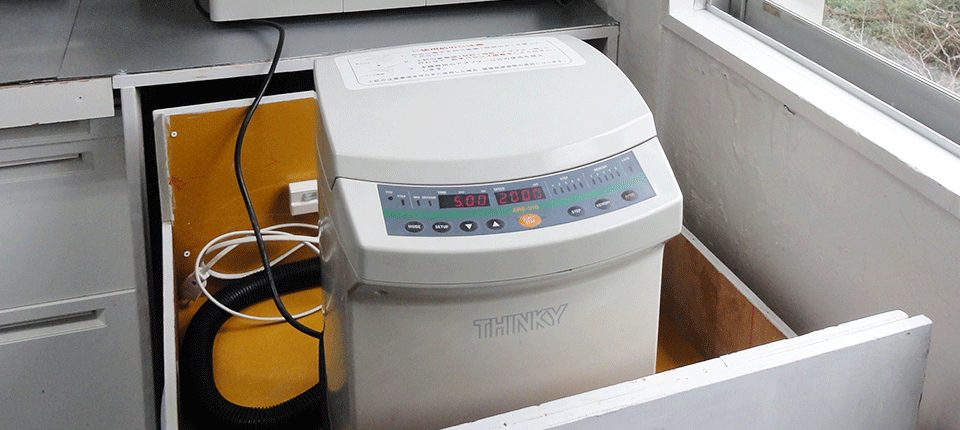
*THINKY Mixer on a handmade workbench. Other similar shelves were designed for ease of use.